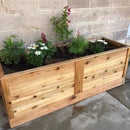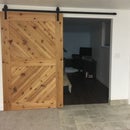Introduction: Dark Knight Wall Clock
I found this gem originally by tophattaylor_uk months ago. I made my first clock the classic Batman and gave it away to a friend, she loves it. I couldn't resist making another for the Remix contest but I mixed it up a bit with the Dark Knight logo.
It is a very easy project that anyone can do! The Dark Knight is a little easier to cut out then the classic.
It didn't cost anything because I used scraps, had the clock parts, plus the paint from the first clock. Although if you don't collect random things or have the tools yet it will still be very cheap to create.
Materials
- Paper cut out
- MDF or Wood
- Quartz Clock Mechanism
- Marker, Scissors, Tape
- Paint
Tools
- Jigsaw
- Drill
- Sandpaper 150 grit
- Tape Measurer
Overall dimensions 38 cm X 12.5 cm X 0.635 cm (L x H x D)
Attention!
Please read, understand, and follow instruction manuals for all power tools. Wear your safety glasses.
Step 1: Making a Template
Step 1:
Search for a batman logo. In order to make the logo large enough for the clock mechanism to be hidden on the back of the clock go to Tools ---> Adjust Size.
Open the logo in Numbers because Numbers it will print the logo onto multiple pages. Print. (Mac)
Step 2:
Tape the pages together and cut out the logo.
Step 3:
Tape logo to the material in my case mdf and trace it with something that is easily visible. I took advantage of the straight edge at the top of the mdf to reduce the amount of cuts.
Step 2: Jigsaw
A jigsaw is a great beginner hand held power tool that is great for cutting curves. The saw can be used to cut different materials including metal and wood with the use of different types of blades.
Using the Jigsaw
1. Clamping the cutting material down, securing it making it easier to focus on the cut. Check to make sure that the cutting path is clear.
2. Place the front of the shoe down firmly on the material. Keep it flat against material for a square cut.
3. Don't start the saw with the blade touching the material. Instead start the saw, at full speed start cutting.
4. Don't force the tool; let the blade cut at its own speed. Take your time to make the best cut possible.
5. When making relief cuts or coming to the end of a cut let the blade come to a complete stop before removing from the material.
Parts of the Jigsaw
All jigsaws vary a little but usually have the same features.
Variable Speed Switch - Controls the blade strokes-per-minute (S.P.M).
Dust Blower - A blower to clear the cutting area of debris created while cutting.
Shoe - The bottom of the saw that is in contact with material when cutting.
Bevel Cutting Adjustment - Bevel cuts can be made at angles from 0 - 45 degrees. This project will be at 0.
Trigger - Pull the trigger to turn on the saw. Let it go to turn it off. Some saws also have a "lock" so holding the trigger isn't required while cutting.
Step 3: Cut It Out
Remember it is better to leave the line and sand a little extra than it is to cut too far and need to start over.
Step 1:
Clamp material down. Re-clamp material whenever necessary to avoid cutting anything you rather not cut.
Step 2:
From the top, cut the first curve of the wing until just after the corner. Let the blade come to a complete stop, remove the blade from material. Start again from the outside to cut the second curve. Flip and repeat for the other wing.
For the head of batman cut several relief cuts to make the tight curves easier. Between the ears make several relief cuts until the blade fits on top of Batman's head. It is easy to finish the cut across his head once that is complete.
Step 4: How to Sand
Sandpaper grits range from coarse to fine. The smaller the number usually the rougher the grit. Coarse are those under 100 grit, medium grit is 100 to 180 grit, and a fine grit is anything above that.
To prepare wood for paint or stain start with 80 grit, next with 100, then 120, again with 150, don't miss 180, and if there are still noticeable scratches use 220. Sand with the grain of the wood to help avoid scratches. Remember if scratches are noticeable now, they will really show when stain or finish is applied.
The rough sandpaper will remove many defects and scratches in the wood quickly but will also create many. That is why starting low and gradually moving up is important.
When using an orbital sander or belter sander keep the sander moving rather than in one place. This will avoid having peaks and valleys in the material. Using a block will help keep square edges and help prevent peaks and valleys.
Step 1:
For this project use ~150 grit and a block or large diameter dowel to sand edges of the curves to the outline. Be careful not to sand the face of the clock if you used mdf unless you plan on sanding to a higher grit. It scratches easily and will show up after painting.
Step 2:
Round the corners and edges just a little by going over them once or twice.
Step 5: Drill Hole for Clock Mechanism
Step 1:
Find the center of the clock by measuring the length and height. Make sure that the clock mechanism will be hidden completely from the front view. I found the center but decided to lower the hole because I felt the hands looked better in the lower position. Put the clock mechanism in place before drilling the hole. Check that there is material all around the mechanism to ensure it won't be seen from the front.
Step 2:
Measure the diameter of the clock mechanism that will stick through the Batman cut out. Use a drill bit that fits that diameter the best. Too small and it won't fit, too big and it will be loose.
Step 3:
Use a piece of scrap wood under the clock to drill into. This will reduce "blow out" and save your table from new holes. Drill the hole on the center mark. You may need to do a little touch up sanding.
Step 6: Painting & Finishing Up
Step 1:
Paint in a well ventilated area. I did many coats until I was satisfied the mdf was done soaking the paint up. PVA is used to seal the edges as well.
I wasn't a fan of the clock hands I had on hand so I made adjustments.
Allow paint time do dry.
Step 2:
Assemble clock, hang, and enjoy!

Participated in the
Teach It! Contest Sponsored by Dremel

Participated in the
Remix Contest













